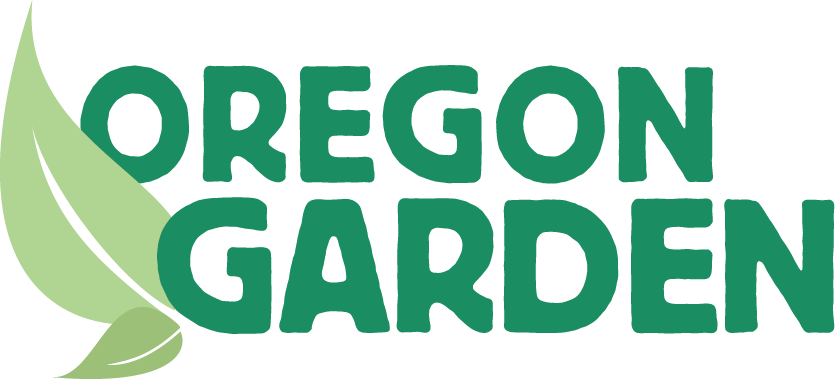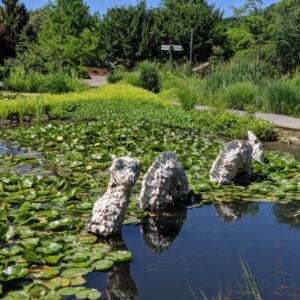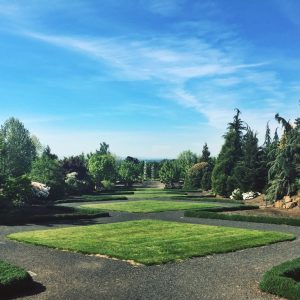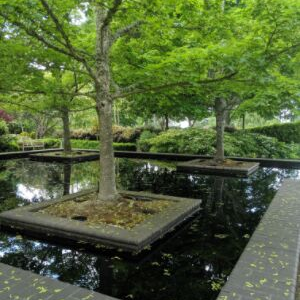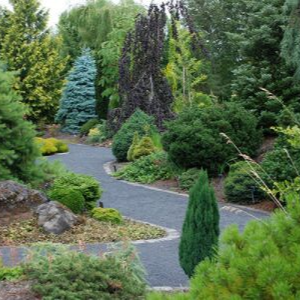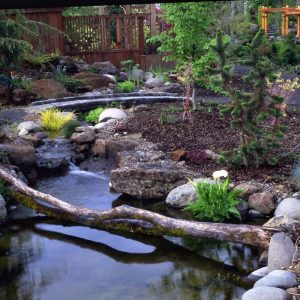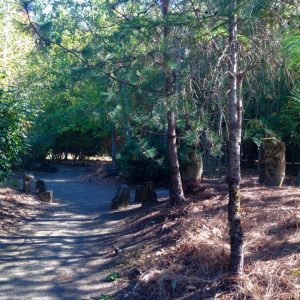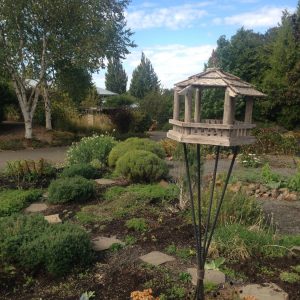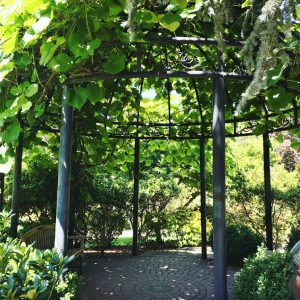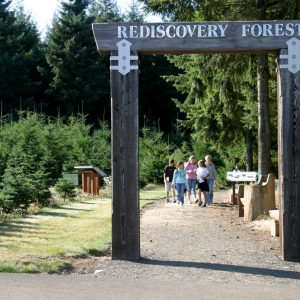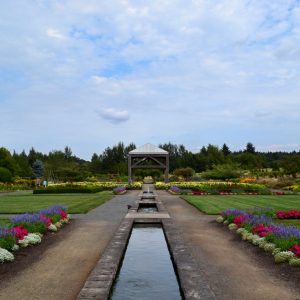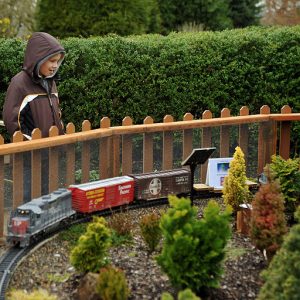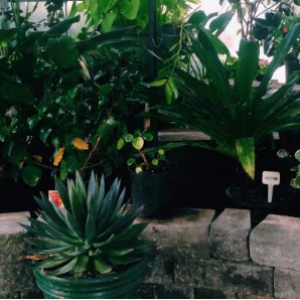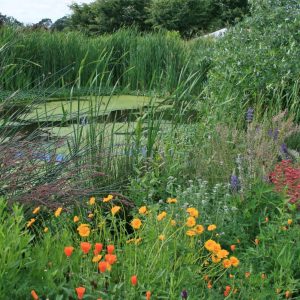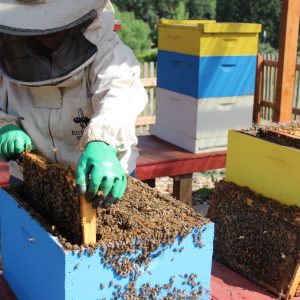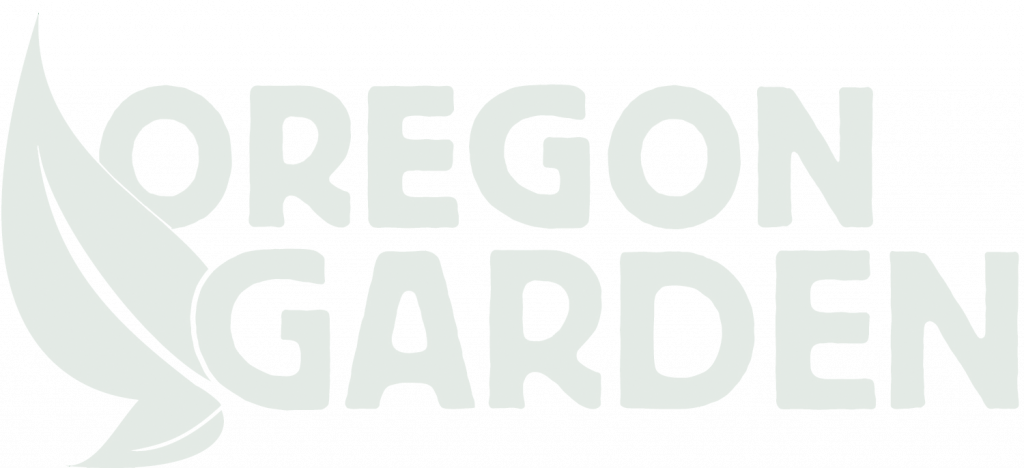Themed Gardens
The Oregon Garden is an 80-acre botanical garden, featuring more than 20 specialty gardens showcasing the diverse botanical beauty that can be found in the Willamette Valley and throughout the Pacific Northwest. Click below to find out more about our themed gardens.
The award-winning A-Mazing Water Garden elegantly incorporates a circular water garden with an ornate bridge, criss-crossing paths (hence it’s name) and a cascading water wall. This area combines wildlife habitat and treated wastewater recycling to create a unique botanical haven, functions that are typically kept separate. It is a shining example of how public gardens can serve multiple purposes and also serve their communities.
The Axis Garden is the spine of the Garden – located at its “top” is the Axis Fountain, which offers a wonderful view all the way down to the Lupine Fugue, Rose Petal Fountain and the Willamette Valley beyond. The Axis Garden itself is one of our more formal gardens, comprised of turf diamonds and teucrium hedges forming triangular beds that are planted with seasonal color.
Bosque (bohs-kay’) is a Spanish word meaning “grove”. The Bosque serves as the heart of the Garden. It is a large central plaza featuring four brick reflecting ponds and 40 planter boxes, each planted with a single Pacific Sunset Maple. The colorful foliage of the maple trees reflect in the dark surface of the ponds, and are especially striking in the fall. This spectacular garden is often home to both private and public events.
Let your imagination run wild – as well as the kids – in the Children’s Garden!
- Discover dinosaur bones in our ‘Dinosaur Dig’.
- Pretend you are living in the jungle at the top of the trees in our tree house.
- Make believe you’ve been magically transported to the land of the Hobbits, and climb in and over a real Hobbit House.
Of course, this is still a garden, so wonder at the animal-shaped topiary, watch the furniture garden grow, and figure out why the “weird plants” look like they do.
The Conifer Garden, a great example of year-round interest, boasts one of the largest collections of dwarf and miniature conifers in the United States. Some are one-of-a-kind and have been collected from around the world. The garden also includes a variety of companion plants such as Japanese maples, daphnes, heathers and heaths.
This unique, specialty garden was built in partnership with the Western Region of the American Conifer Society. The Western Region provides on-going expertise to assure the Garden remains one of the finest showcases for conifers in the country.
The Home Demonstration Gardens are a series of small gardens that are designed to inspire gardeners with ideas they can take home. Each Garden highlights specific concepts that might be appealing to the home gardener, such as creating an edible landscape, building a water feature or creating color with annuals. They are designed on a scale more suited to the home garden.
The Honor Garden is dedicated to the 165 donors whose generous spirit helped build The Oregon Garden during its formative years, 1993 to 2002. Recognition is given to Art Anderson, who was the first Oregon Garden Board president (1994-98), and Clayton Hannon, the first executive director (1994-97), both of whom deserve credit for leading this great effort. Names of all the contributing individuals, foundations, nurseries, corporations, membership organizations and government agencies are displayed on eight cedar totem poles.
The Lewis and Clark Garden is a living museum of the many botanical finds Meriwether Lewis and William Clark documented on their Corps of Discovery’s journey more than 200 years ago. Travel through the diverse regions of the Pacific Northwest as Lewis and Clark did: sit at their campsite along the rushing stream, look out over the dry steppes of the Columbia Plateau, and say goodbye to the lush forest of the Pacific Coast before journeying home.
The Medicinal Garden displays a variety of plant species that can be grown in our climate with beneficial properties. Each plant has, or was believed to have, medicinal properties when correctly prepared, including lavender, hyssop and borage. This is also a great garden for spotting pollinators such as bees and butterflies, which also love the often-fragrant flowers found here.
The Northwest Garden’s landscape design showcases plants and trees that thrive in our region. Visitors experience meandering pathways through lush garden beds filled with color, texture, form and movement. Highlights include a large pergola covered in vines and an area created in partnership with Monrovia nursery. This was one of our first completed gardens and is an excellent place to spend some time if you are looking for ideas in your own Northwest landscape.
We love animals, yes we do! Bring Fido, and let him check out the Pet Friendly Garden, which educates visitors to The Oregon Garden as to which plants are friendly and which are toxic to pets. The space provided, although not large, addresses the issues of creating a landscape that accommodates pets as well as other Garden wildlife through the use of water features, bird baths, etc. In this Garden you will also find a memorial of Silverton’s own Bobbie the Wonder Dog.
The Oregon Garden’s Rediscovery Forest offers a peaceful respite in the shade of Douglas firs and singing birds. This demonstration forest, managed in partnership with the Oregon Forest Resources Institute (OFRI) serves the multiple goals of education, research and public enjoyment.
Hike the different trails through this dynamic demonstration forest. You will learn about reforestation, forest management, seed tree forests, growing Christmas trees, and hardwood forest management through the interpretive signage placed along easily-accessible trails.
Agricultural products grown in the Willamette Valley are showcased in the Silverton Market Garden. Many of the 147 Oregon crops are represented, including berries, grapes, other fruits, grass seed, hops and assorted vegetables. A rill filled with water runs through the center of this garden and ends in a small waterfall, symbolizing nearby Silver Falls. As a connection to the nearby Children’s Garden, there are a series of raised vegetable beds and a working, old-fashioned water pump where visitors are encouraged to do some hands-on gardening.
Adjacent to the Children’s Garden, the Train Garden is a must see for everyone young or old.
The train is roughly 1/20th the size of an early 1970’s Southern Pacific train that once ran through Silverton and neighboring towns throughout the Willamette Valley. The feature consists of 120 feet of circular track, looping the 1970’s Southern Pacific diesel style engine complete with two box cars, two flat cars and a caboose, around a mountain and through hedges. Dwarf conifers and other small plants are set in place along the route, their size and species intentionally coordinated with the train’s G-scale proportions. The goal is to show how to use limited garden space and appeal to children.
Tropical House
Adjacent to the Pavilion The Tropical House features many plants people have seen while on vacation in warmer climates, including hibiscus, oleander, mandavilla, orchids and bananas, just to name a few. Because these plants are from tropical and subtropical regions, the environment is kept warm and humid.
Wetlands
The Weltands are an innovative, pioneering program in partnership with the City of Silverton in which the area’s treated waste water is used to create a thriving wetlands habitat for a variety of wildlife and plants.
The water travels at the rate of 300 gallons per minute in peak season through a series of terraced ponds with cascading water, pools and wetlands plants, into a holding tank where it then flows into an irrigation system — a unique and attractive method of using treated water to irrigate the Garden. The Wetlands also play an active role in the education programs at the Garden.
